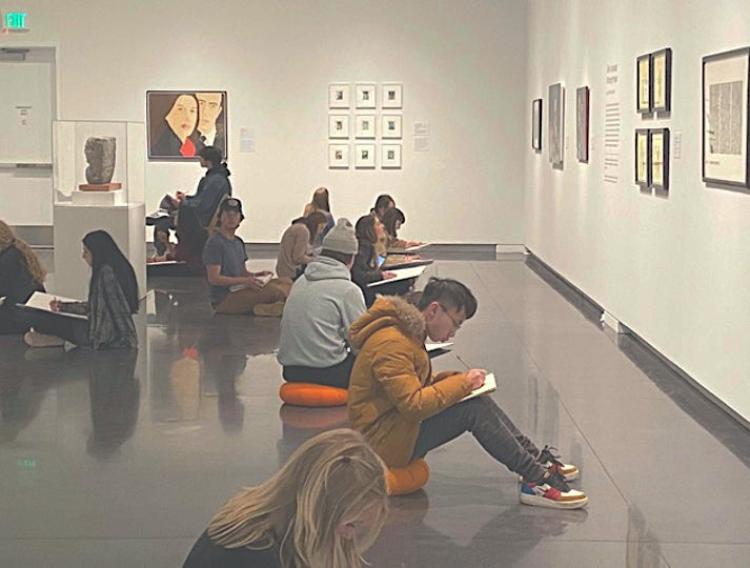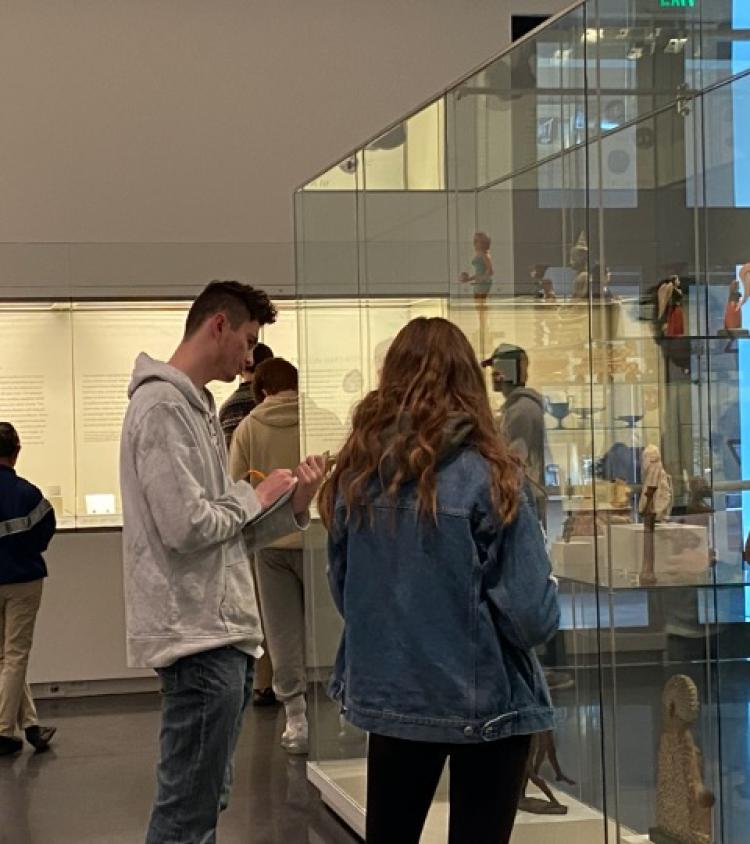Math alum sows seeds of diversity in art
$25K gift establishes Diversity Acquisition Fund at CU Boulder Art Museum
In fall semester 2020, Hope Saska, decided to create a new collection plan for the University of Colorado Boulder Art Museum.
“It’s a document to articulate what we collect and why we collect it, and what our mission is,” says Saska, curator of collections and exhibitions at the museum. “It also is a history of the collection, so we can better understand past motivations.”
Started in the 1940s, the art museum’s collection accumulated over the decades in a broad, general direction. Saska thought it was a good time to sharpen the focus.

At the top of the page: Persuasive Prints (Installation view), CU Art Museum, February 6–March 12, 2020. Photo by Patrick Campbell, © University of Colorado Boulder. Above: Body Language: Picturing People (Installation view), CU Art Museum, July 18, 2019– March 12, 2020. Photo by Patrick Campbell, © University of Colorado Boulder.
“It occurred to me that we should be more intentional about charting a direction for the future, thinking about where opportunities might be to expand, and thinking about diversity was really important,” she says. “We needed to find a clear path, and if we were reimagining, why not be as broad and diverse as possible.”
Enter Ann Bateson, a long-time Boulder resident who earned a PhD in mathematics in 1977 and spent much of her career working at the Center for the Study of Earth From Space—now the Earth Science and Observation Center at CIRES, the Cooperative Institute for Research in Environmental Science.
A current member of the museum’s collection committee, Bateson made a $25,000 donation as a seed endowment of the new Diversity Acquisition Fund, which will be used to acquire works by historically underrepresented artists such as artists of color, artists with disabilities, and LGBTQ+ artists.
Once fully endowed, the fund will spend 4% of its principal annually to purchase work for the collection.
“Ann’s seed gift will hopefully encourage others to donate, to help the museum develop this aspect of our collection,” Saska says.
“I’m very excited to be a part of it,” Bateson says. “I’m excited that the museum is creating a space that feels inclusive to all students and addresses issues of importance to them.”
I’m excited that the museum is creating a space that feels inclusive to all students and addresses issues of importance to them."
Bateson’s sister is an artist (“but I’m not at all!” she says) and she grew up in Dallas, a significant regional hub for the arts. She’s always been struck by the story of Emma Lee Moss, a domestic worker in Dallas who was able to build her career as an artist only after receiving a small trust fund from her former husband’s mother upon her death.
“She became an accomplished folk artist and built up a reputation,” Bateson says. “But she couldn’t practice and develop her work until she received that support.”

CU Art Museum Exhibition Gallery. Photo by Patrick Campbell, © University of Colorado Boulder.
Because the fund won’t be in a position to purchase art immediately, the museum has designated funds in its interim collection plan to bridge the gap, Saska says.
The museum has already begun developing a network of connections to curators and institutions across the nation to build on their expertise in creating a more diverse collection.
“We are able to have Zoom meetings with artists working in New York or Chicago or Los Angeles, and talking to curators,” she says. “In a strange way, the (COVID-19) pandemic has allowed us to have these conversations; being isolated has encouraged this moment of network building and re-evaluation.”
But Saska says there is already one clear direction for acquisitions: works on paper, building on the $1.35 million 2018 acquisition of the “Sharkive”—750 original works and 2,000 related materials from the Lyons-based printmaking studio started by artists Bud and Barbara Shark in the 1970s, now known as Shark’s Ink.
“There are a lot of artists of color who are printmakers,” says Saska, who wrote her doctoral dissertation at Brown University on 18th-century graphic satire and caricature. “We will be able to acquire this kind of work, in terms of funding, and it’s also very easy to use in teaching. This provides a focus on something that is attainable.”
Works on paper are also easy to use in teaching, will facilitate the museum’s ongoing effort to expand interdisciplinary scholarship and teaching and fit into the university’s efforts to meet the needs of future students.
“Anchored by (the) study of, and interaction with, campus collections of material culture and natural specimens, this academy has the potential to impart skills across disciplines, modeling applications of ‘transfer learning’ where knowledge gained in one domain is applied to another,” Saska wrote with Jessica Brunecky, director of visitor experience and finance at the CU Art Museum in a 2019 paper for the university’s Academic Futures initiative.
While the museum’s diversity fund won’t be dedicated exclusively to works on paper, Saska says building on the Sharkive will make CU Boulder “a real center of gravity for this material, regionally.”
“Sometimes the rap on museums is that they are elite places for only certain types of audience,” she says. “But we’re hoping to get away from that, and this is will help us be more responsive to our community.”
Donations to the CU Boulder Art Museum Diversity Acquisition Fund can be made on the Colorado Giving Page.

